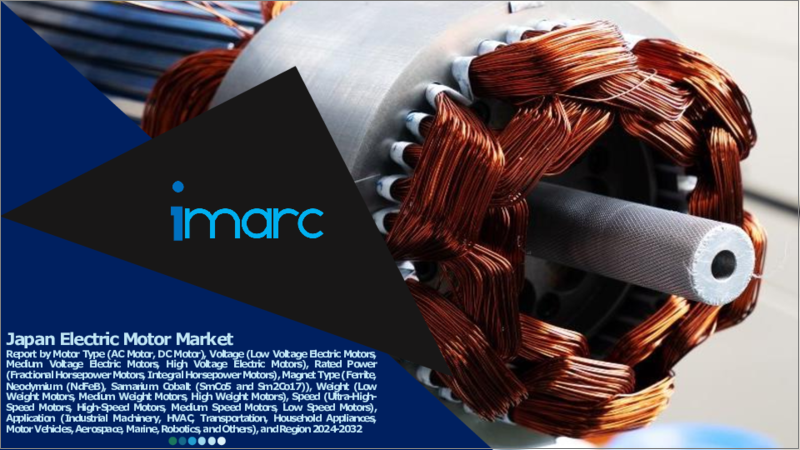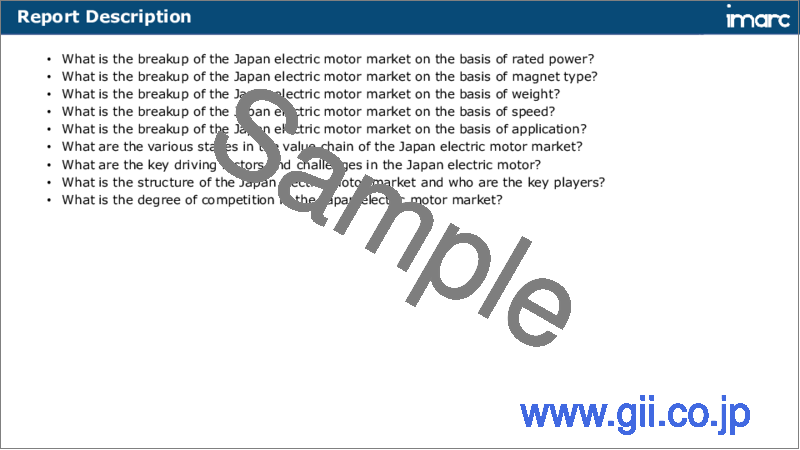|
|
市場調査レポート
商品コード
1609647
日本電動モーター市場レポート:モータータイプ、電圧、定格電力、磁石タイプ、重量、速度、用途、地域別、2024年~2032年Japan Electric Motor Market Report by Motor Type, Voltage, Rated Power, Magnet Type (Ferrite, Neodymium, Samarium Cobalt ), Weight, Speed, Application, and Region 2024-2032 |
||||||
カスタマイズ可能
|
|||||||
| 日本電動モーター市場レポート:モータータイプ、電圧、定格電力、磁石タイプ、重量、速度、用途、地域別、2024年~2032年 |
|
出版日: 2024年12月05日
発行: IMARC
ページ情報: 英文 121 Pages
納期: 5~7営業日
|
- 全表示
- 概要
- 目次
日本電動モーター市場の市場規模は2023年に660万米ドルに達しました。今後、IMARC Groupは、市場は2032年までに3,820万米ドルに達し、2024年から2032年の間に21.56%の成長率(CAGR)を示すと予測しています。市場は、省エネルギーへの関心の高まり、政府の支援政策、電気自動車の出現、産業オートメーションへの傾斜の高まり、技術の顕著な進歩、費用対効果の高いソリューションによって牽引されています。
本レポートで扱う主な質問
- 日本電動モーター市場のこれまでの業績と、今後数年間の業績は?
- COVID-19が日本電動モーター市場に与えた影響は?
- 日本電動モーター市場のモータータイプ別の内訳は?
- 日本電動モーター市場の電圧別の内訳は?
- 日本電動モーター市場のブレークアップを定格電力別に教えてください。
- 日本電動モーター市場のブレークアップをマグネットタイプ別に教えてください。
- 日本電動モーター市場の重量の内訳を教えてください。
- 日本電動モーター市場のブレークアップをスピード別に教えてください。
- 日本電動モーター市場の用途別の内訳は?
- 日本電動モーター市場のバリューチェーンにはどのような段階がありますか?
- 日本の電動モータの主な促進要因と課題は?
- 日本電動モーター市場の構造と主要プレーヤーは?
- 日本電動モーター市場における競合の程度は?
目次
第1章 序文
第2章 調査範囲と調査手法
- 調査の目的
- ステークホルダー
- データソース
- 市場推定
- 調査手法
第3章 エグゼクティブサマリー
第4章 日本電動モーター市場-イントロダクション
- 概要
- 市場力学
- 業界動向
- 競合情報
第5章 日本電動モーター市場情勢
- 過去および現在の市場動向(2018~2023年)
- 市場予測(2024~2032年)
第6章 日本電動モーター市場- モータータイプ別の内訳
- ACモーター
- DCモーター
第7章 日本電動モーター市場- 電圧別分解
- 低電圧電動モーター
- 中電圧電動モーター
- 高電圧電動モーター
第8章 日本電動モーター市場- 定格電力別内訳
- 分数馬力モーター
- インテグラル馬力モーター
第9章 日本電動モーター市場- 磁石タイプ別分解
- フェライト
- ネオジム(NdFeB)
- サマリウムコバルト(SmCo5およびSm2Co17)
第10章 日本電動モーター市場- 重量別内訳
- 軽量モーター
- 中型モーター
- 高重量モーター
第11章 日本電動モーター市場- 速度別分割
- 超高速モーター
- 高速モーター
- 中速モーター
- 低速モーター
第12章 日本電動モーター市場- 用途別の内訳
- 産業機械
- 空調設備
- 交通機関
- 家電製品
- 自動車
- 航空宇宙
- 海洋
- ロボット工学
- その他
第12章 日本電動モーター市場-競合情勢
- 概要
- 市場構造
- 市場プレーヤーのポジショニング
- 主要成功戦略
- 競合ダッシュボード
- 企業評価象限
第13章 主要企業のプロファイル
第14章 日本電動モーター市場- 業界分析
- 促進要因・抑制要因・機会
- ポーターのファイブフォース分析
- バリューチェーン分析
第15章 付録
Japan electric motor market size reached US$ 6.6 Million in 2023. Looking forward, IMARC Group expects the market to reach US$ 38.2 Million by 2032, exhibiting a growth rate (CAGR) of 21.56% during 2024-2032. The market is being driven by a growing focus on energy conservation, supportive government policies, the emergence of electric vehicles, the growing inclination towards industrial automation, notable advancements in technology, and cost-effective solutions.
An electric motor transforms electrical energy into mechanical energy, facilitating the movement derived from electrical power. This transformation relies on the principles of electromagnetism, where the interplay between electric currents and magnetic fields produces a mechanical force. Essential components of an electric motor encompass the stator and rotor. The stator, a fixed segment, typically contains coils that, when energized by electricity, generate a magnetic field. In contrast, the rotor, which is the moving part, usually features permanent magnets or electromagnets. As electric current courses through the stator coils, a magnetic field emerges. This field then engages with the rotor's magnetic field, prompting the rotor to rotate.
Japan Electric Motor Market Trends:
The electric motor market in Japan has consistently been at the forefront of innovation and growth, echoing the nation's rich technological legacy and its commitment to sustainable energy solutions. Rooted in Japan's meticulous manufacturing traditions, electric motors produced here are renowned globally for their efficiency, reliability, and advanced engineering. The nation's rapid urbanization, coupled with its vision of a sustainable future, has spurred demand for energy-efficient appliances and electric vehicles, both of which rely heavily on electric motors. Furthermore, the Japanese government's proactive stance on reducing carbon footprints has ushered in supportive policies, incentivizing industries to adopt energy-efficient systems. This has further amplified the deployment of electric motors in various sectors, ranging from transportation to industrial automation. Another pivotal factor fueling the market's growth is Japan's increasing focus on electric vehicles (EVs), given the shift towards cleaner transportation solutions. With leading automakers headquartered in Japan, the demand for high-performance electric motors for EVs has seen a significant surge. In essence, the electric motor market in Japan thrives on a blend of cutting-edge technology, supportive governmental policies, and the nation's overarching aim for an eco-friendly, energy-efficient future.
Japan Electric Motor Market Segmentation:
Motor Type Insights:
- AC Motor
- Induction AC Motor
- Synchronous AC Motor
- DC Motor
- Brushed DC Motor
- Brushless DC Motor
Voltage Insights:
- Low Voltage Electric Motors
- Medium Voltage Electric Motors
- High Voltage Electric Motors
Rated Power Insights:
- Fractional Horsepower Motors
- Fractional Horsepower (< 1/8) Motors
- Fractional Horsepower (1/8 - 1/2) Motors
- Fractional Horsepower (1/2 - 1) Motors
- Integral Horsepower Motors
- Integral Horsepower (1 - 5) Motors
- Integral Horsepower (10 - 50) Motors
- Integral Horsepower (50 - 100) Motors
- Integral Horsepower (>100) Motors
Magnet Type Insights:
- Ferrite
- Neodymium (NdFeB)
- Samarium Cobalt (SmCo5 and Sm2Co17)
Weight Insights:
- Low Weight Motors
- Medium Weight Motors
- High Weight Motors
Speed Insights:
- Ultra-High-Speed Motors
- High-Speed Motors
- Medium Speed Motors
- Low Speed Motors
Application Insights:
- Industrial Machinery
- HVAC
- Transportation
- Household Appliances
- Motor Vehicles
- Aerospace
- Marine
- Robotics
- Others
Competitive Landscape:
The market research report has also provided a comprehensive analysis of the competitive landscape. Competitive analysis such as market structure, key player positioning, top winning strategies, competitive dashboard, and company evaluation quadrant has been covered in the report. Also, detailed profiles of all major companies have been provided.
Key Questions Answered in This Report:
- How has the Japan electric motor market performed so far and how will it perform in the coming years?
- What has been the impact of COVID-19 on the Japan electric motor market?
- What is the breakup of the Japan electric motor market on the basis of motor type?
- What is the breakup of the Japan electric motor market on the basis of voltage?
- What is the breakup of the Japan electric motor market on the basis of rated power?
- What is the breakup of the Japan electric motor market on the basis of magnet type?
- What is the breakup of the Japan electric motor market on the basis of weight?
- What is the breakup of the Japan electric motor market on the basis of speed?
- What is the breakup of the Japan electric motor market on the basis of application?
- What are the various stages in the value chain of the Japan electric motor market?
- What are the key driving factors and challenges in the Japan electric motor?
- What is the structure of the Japan electric motor market and who are the key players?
- What is the degree of competition in the Japan electric motor market?
Table of Contents
1 Preface
2 Scope and Methodology
- 2.1 Objectives of the Study
- 2.2 Stakeholders
- 2.3 Data Sources
- 2.3.1 Primary Sources
- 2.3.2 Secondary Sources
- 2.4 Market Estimation
- 2.4.1 Bottom-Up Approach
- 2.4.2 Top-Down Approach
- 2.5 Forecasting Methodology
3 Executive Summary
4 Japan Electric Motor Market - Introduction
- 4.1 Overview
- 4.2 Market Dynamics
- 4.3 Industry Trends
- 4.4 Competitive Intelligence
5 Japan Electric Motor Market Landscape
- 5.1 Historical and Current Market Trends (2018-2023)
- 5.2 Market Forecast (2024-2032)
6 Japan Electric Motor Market - Breakup by Motor Type
- 6.1 AC Motor
- 6.1.1 Overview
- 6.1.2 Historical and Current Market Trends (2018-2023)
- 6.1.3 Market Segmentation
- 6.1.3.1 Induction AC Motor
- 6.1.3.2 Synchronous AC Motor
- 6.1.4 Market Forecast (2024-2032)
- 6.2 DC Motor
- 6.2.1 Overview
- 6.2.2 Historical and Current Market Trends (2018-2023)
- 6.2.3 Market Segmentation
- 6.2.3.1 Brushed DC Motor
- 6.2.3.2 Brushless DC Motor
- 6.2.4 Market Forecast (2024-2032)
7 Japan Electric Motor Market - Breakup by Voltage
- 7.1 Low Voltage Electric Motors
- 7.1.1 Overview
- 7.1.2 Historical and Current Market Trends (2018-2023)
- 7.1.3 Market Forecast (2024-2032)
- 7.2 Medium Voltage Electric Motors
- 7.2.1 Overview
- 7.2.2 Historical and Current Market Trends (2018-2023)
- 7.2.3 Market Forecast (2024-2032)
- 7.3 High Voltage Electric Motors
- 7.3.1 Overview
- 7.3.2 Historical and Current Market Trends (2018-2023)
- 7.3.3 Market Forecast (2024-2032)
8 Japan Electric Motor Market - Breakup by Rated Power
- 8.1 Fractional Horsepower Motors
- 8.1.1 Overview
- 8.1.2 Historical and Current Market Trends (2018-2023)
- 8.1.3 Market Segmentation
- 8.1.3.1 Fractional Horsepower (< 1/8) Motors
- 8.1.3.2 Fractional Horsepower (1/8 - 1/2) Motors
- 8.1.3.3 Fractional Horsepower (1/2 - 1) Motors
- 8.1.4 Market Forecast (2024-2032)
- 8.2 Integral Horsepower Motors
- 8.2.1 Overview
- 8.2.2 Historical and Current Market Trends (2018-2023)
- 8.2.3 Market Segmentation
- 8.2.3.1 Integral Horsepower (1 - 5) Motors
- 8.2.3.2 Integral Horsepower (10 - 50) Motors
- 8.2.3.3 Integral Horsepower (50 - 100) Motors
- 8.2.3.4 Integral Horsepower (>100) Motors
- 8.2.4 Market Forecast (2024-2032)
9 Japan Electric Motor Market - Breakup by Magnet Type
- 9.1 Ferrite
- 9.1.1 Overview
- 9.1.2 Historical and Current Market Trends (2018-2023)
- 9.1.3 Market Forecast (2024-2032)
- 9.2 Neodymium (NdFeB)
- 9.2.1 Overview
- 9.2.2 Historical and Current Market Trends (2018-2023)
- 9.2.3 Market Forecast (2024-2032)
- 9.3 Samarium Cobalt (SmCo5 and Sm2Co17)
- 9.3.1 Overview
- 9.3.2 Historical and Current Market Trends (2018-2023)
- 9.3.3 Market Forecast (2024-2032)
10 Japan Electric Motor Market - Breakup by Weight
- 10.1 Low Weight Motors
- 10.1.1 Overview
- 10.1.2 Historical and Current Market Trends (2018-2023)
- 10.1.3 Market Forecast (2024-2032)
- 10.2 Medium Weight Motors
- 10.2.1 Overview
- 10.2.2 Historical and Current Market Trends (2018-2023)
- 10.2.3 Market Forecast (2024-2032)
- 10.3 High Weight Motors
- 10.3.1 Overview
- 10.3.2 Historical and Current Market Trends (2018-2023)
- 10.3.3 Market Forecast (2024-2032)
11 Japan Electric Motor Market - Breakup by Speed
- 11.1 Ultra-High-Speed Motors
- 11.1.1 Overview
- 11.1.2 Historical and Current Market Trends (2018-2023)
- 11.1.3 Market Forecast (2024-2032)
- 11.2 High-Speed Motors
- 11.2.1 Overview
- 11.2.2 Historical and Current Market Trends (2018-2023)
- 11.2.3 Market Forecast (2024-2032)
- 11.3 Medium Speed Motors
- 11.3.1 Overview
- 11.3.2 Historical and Current Market Trends (2018-2023)
- 11.3.3 Market Forecast (2024-2032)
- 11.4 Low Speed Motors
- 11.4.1 Overview
- 11.4.2 Historical and Current Market Trends (2018-2023)
- 11.4.3 Market Forecast (2024-2032)
12 Japan Electric Motor Market - Breakup by Application
- 12.1 Industrial Machinery
- 12.1.1 Overview
- 12.1.2 Historical and Current Market Trends (2018-2023)
- 12.1.3 Market Forecast (2024-2032)
- 12.2 HVAC
- 12.2.1 Overview
- 12.2.2 Historical and Current Market Trends (2018-2023)
- 12.2.3 Market Forecast (2024-2032)
- 12.3 Transportation
- 12.3.1 Overview
- 12.3.2 Historical and Current Market Trends (2018-2023)
- 12.3.3 Market Forecast (2024-2032)
- 12.4 Household Appliances
- 12.4.1 Overview
- 12.4.2 Historical and Current Market Trends (2018-2023)
- 12.4.3 Market Forecast (2024-2032)
- 12.5 Motor Vehicles
- 12.5.1 Overview
- 12.5.2 Historical and Current Market Trends (2018-2023)
- 12.5.3 Market Forecast (2024-2032)
- 12.6 Aerospace
- 12.6.1 Overview
- 12.6.2 Historical and Current Market Trends (2018-2023)
- 12.6.3 Market Forecast (2024-2032)
- 12.7 Marine
- 12.7.1 Overview
- 12.7.2 Historical and Current Market Trends (2018-2023)
- 12.7.3 Market Forecast (2024-2032)
- 12.8 Robotics
- 12.8.1 Overview
- 12.8.2 Historical and Current Market Trends (2018-2023)
- 12.8.3 Market Forecast (2024-2032)
- 12.9 Others
- 12.9.1 Historical and Current Market Trends (2018-2023)
- 12.9.2 Market Forecast (2024-2032)
12 Japan Electric Motor Market - Competitive Landscape
- 12.1 Overview
- 12.2 Market Structure
- 12.3 Market Player Positioning
- 12.4 Top Winning Strategies
- 12.5 Competitive Dashboard
- 12.6 Company Evaluation Quadrant
13 Profiles of Key Players
- 13.1 Company A
- 13.1.1 Business Overview
- 13.1.2 Product Portfolio
- 13.1.3 Business Strategies
- 13.1.4 SWOT Analysis
- 13.1.5 Major News and Events
- 13.2 Company B
- 13.2.1 Business Overview
- 13.2.2 Product Portfolio
- 13.2.3 Business Strategies
- 13.2.4 SWOT Analysis
- 13.2.5 Major News and Events
- 13.3 Company C
- 13.3.1 Business Overview
- 13.3.2 Product Portfolio
- 13.3.3 Business Strategies
- 13.3.4 SWOT Analysis
- 13.3.5 Major News and Events
- 13.4 Company D
- 13.4.1 Business Overview
- 13.4.2 Product Portfolio
- 13.4.3 Business Strategies
- 13.4.4 SWOT Analysis
- 13.4.5 Major News and Events
- 13.5 Company E
- 13.5.1 Business Overview
- 13.5.2 Product Portfolio
- 13.5.3 Business Strategies
- 13.5.4 SWOT Analysis
- 13.5.5 Major News and Events
14 Japan Electric Motor Market - Industry Analysis
- 14.1 Drivers, Restraints, and Opportunities
- 14.1.1 Overview
- 14.1.2 Drivers
- 14.1.3 Restraints
- 14.1.4 Opportunities
- 14.2 Porters Five Forces Analysis
- 14.2.1 Overview
- 14.2.2 Bargaining Power of Buyers
- 14.2.3 Bargaining Power of Suppliers
- 14.2.4 Degree of Competition
- 14.2.5 Threat of New Entrants
- 14.2.6 Threat of Substitutes
- 14.3 Value Chain Analysis





